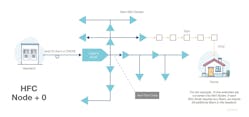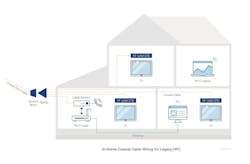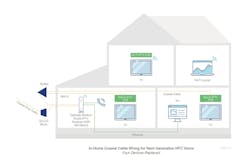Cable networks are already the preeminent platform for transmission of data services for both residential and business customers. Lately, however, there is speculation that new networks, perhaps driven by next-generation wireless advances, will be required to fulfill anticipated needs.
How can cable be ready for this transition? One way might be through “Next-Generation Hybrid Fiber Coax” (NG HFC), which includes Distributed Access Architecture (DAA), Node+0, Full Duplex DOCSIS (FDD) and Extended Spectrum DOCSIS (ESD). While fiber to the home (FTTH) is also a possibility, let’s look at the parts of the network that NG HFC might change.
Node+0
To take speeds significantly higher than possible with 500-home nodes, dropping the service group size to numbers similar to PON (32, 64 or 128 homes) is required. (Figure 1) Further, current lab implementations of FDD require Node + 0.
Distributed Access Architecture
Remote Physical Layer (Remote PHY) or Remote Media Access Control and Physical Layer (Remote MAC-PHY) define DAA. DAA solves many MSO challenges. By putting the majority of headend equipment into the field, space and power in the headend become available for other purposes. Indeed, without DAA there would probably be insufficient space and power in the headend to support the number of new nodes required for Node+0.
Combining DAA and Node+0
With DAA, quadrature amplitude modulation (QAM) signals are generated at the node. They need not pass through amplifiers before or after hitting the coaxial network, and therefore when combined with Node+0, higher-order modulation can be used than would be possible with a conventional analog fiber system.
Expanding the Bandwidth
To get more speed (capacity) out of an HFC network, operators will want to increase the available bandwidth of the network. The amount of bandwidth available for upstream signals can be increased (at the expense of downstream capability) through FDD. Here, a portion of the traditionally downstream spectrum is used for transmissions in the upstream direction through echo cancellation. With current technology, this requires Node+0 architecture – the echo cancellation will only work in a passive coaxial area.
Overall bandwidth may also be increased by taking the maximum frequency of the network well beyond current 1-GHz limits using ESD. While Node+0 is not required for ESD, the capabilities of RF amplifiers are improved, taps changed and drop materials considered for replacement. In addition, with FDD or ESD the in-home architecture may be changed from an extension of the operator’s RF network into an isolated network. What will these changes require, operationally speaking?
Maintenance: Coaxial networks require routine preventive maintenance and entail ongoing power expense. Signal leakage must be detected and measured, and any leaks repaired. Higher plant bandwidth makes it necessary to detect leaks at multiple frequencies, exposing the plant to ingress from new sources such as small-cell radios. Connectors, if damaged or installed improperly, can allow water intrusion and corrosion, which will impair performance and can cause outages. Power supply batteries must be maintained. Signal levels must be carefully monitored and maintained and may involve status monitoring networks or manual field checks.
Signal leakage detection systems that work using pilot signals injected into the RF spectrum must be modified to work in a DAA environment. The pilot signals will need to be generated at the DAA nodes.
Construction: When upgrading the network, the hardline plant cable itself will remain intact in most cases. The RF amplifiers may be replaced by new DAA fiber nodes for conversion to a Node+0 architecture. These new fibers must be constructed back to a distribution point, typically located at the original node location. This is the construction that operators anticipate. If the network bandwidth is increased during the NG HFC upgrade, however, unanticipated additional construction may be required. The DOCSIS 4.0/ESD specifications will include bandwidth expansion options to 1.8 GHz and beyond along with FDD. In this context, the following elements may need to be changed:
- Tap Plates: Chances are at a minimum the values of tap plates will need to be changed to accommodate high-output RF levels from NG nodes (and perhaps NG amplifiers) and new plates will be required to pass the new ESD frequencies. Tap changes to accommodate FDD echo cancelation are not anticipated but are a possibility.
- Tap Housings: Will the existing tap housing be able to perform adequately at the new frequencies? The entire housing may need to be replaced at each tap location. This affects both the expense of installation and the outages it will create during construction. While one tap manufacturer recently introduced tap plates able to operate at 1.6 GHz using legacy tap housings, most believe that going to 1.8 GHz and beyond will require the housing to be replaced. It is hoped that new housings will not only be able to accommodate 1.8-GHz taps, but also work with 3-GHz taps when they are available.
- Drop Cables: Will an existing RG-6 drop running 100 feet be adequate to deliver a top frequency of 1.8 GHz? If the network is changed to a “Home Gateway” architecture and splitters at the home are not a concern, the answer is likely yes. It is true that these digital signals will arrive at the home with substantially lower RF levels than before; however, most engineers agree that OFDM techniques (used by DOCSIS 3.1) will permit operation at these lower levels.
- Amplifiers: Deploying a Node+N infrastructure with a significant bandwidth extension might only be possible with new amplifiers, and if you are replacing the amplifiers anyway perhaps Node+0 should be reconsidered.
Disruption of Service: It is important to not only consider the cost and difficulty of deploying a network in terms of equipment dollars and man-hours of labor. Customers are connected to the legacy network! Their service must be disrupted as little as possible.
When an HFC network is upgraded, network interruptions are required. These can be minimized through careful planning. However, they will still happen. Each service interruption annoys customers and makes them more likely to switch to a competitor.
Changing to a Node+0 or DAA network requires equipment replacement that will cause all subscribers to lose service during the equipment change. This outage would occur as the amplifier or legacy node is replaced by a new node, and could just be a single outage observed by those customers fed by that amplifier or node.
Changing to a high-bandwidth (ESD) network will involve changes in the passive outside plant. Subscribers could lose service, multiple times if tap housings are changed, and might need to have their property visited if drop cables are replaced.
Changing terminal equipment is the most disruptive activity of all, because each customer must be visited, which means an appointment must be made, often requiring the customer to miss work.
Terminal Equipment: Legacy HFC networks operate in a “plant extension” in-home architecture: the wiring within the home carries the same spectrum as the operator’s outside plant (Figure 2). Devices within the home receive this same downstream spectrum, and two-way devices transmit on the same upstream spectrum as other devices on the plant segment.
When bandwidth is expanded, some NG HFC upgrades will require that the home be converted from an extension of the cable network into a standalone network fed via a home gateway. This is because legacy equipment in the home tied in to the cable network would not function properly with an altered downstream/upstream split in the plant or other equipment in the home operating in FDD mode, or because ESD signal levels through the legacy home wiring would be insufficient. Next-Gen HFC using FDD or ESD may necessitate a change to an “Isolated Home Wiring” configuration (Figure 3). Here, the outside plant terminates on a gateway device, and that device feeds all other devices in the home.
For television in the isolated network, home video gateways terminate data and video services. These gateways then feed “mini” boxes at other TVs in the home via Multimedia over Coax Alliance (MoCA), Ethernet or Wi-Fi.
The Good News
DOCSIS 3.1 modulation techniques enable operation with much lower signal-to-noise ratios that the standard QAM systems used in DOCSIS 3.0 and traditional QAM TV transmission. This ability will enable a very low-level RF signal (perhaps -20 dBmV or lower) to feed devices within the home and operate properly. This low-level operation will be critical if operators are to avoid massive drop and in-home wiring replacement.
Unfortunately, if we rely upon these new DOCSIS techniques to preserve the “plant-extension” architecture within an expanded-bandwidth customer’s home, we must still replace the in-home equipment. Therefore, the savings of not changing to a gateway-based configuration are quite limited. Rather than filtering legacy devices in the ESD or FDD home, operators might decide it best to replace them and change to a gateway-style architecture at the same time.
Testing by CableLabs and others indicate that FDD signal levels from a home should be low enough after passing through a tap to not cause interference to devices in a nearby non-FDD home. In conditions when the isolation is not sufficient to protect the legacy devices, a filter may be required, and could be installed at the tap without a customer appointment.
For ESD, since the legacy home will not be receiving extended spectrum services, they should be able to continue using their legacy equipment in a plant-extension configuration, provided that those services remain on legacy RF channels available to them.
Conclusion
NG HFC offers operators a way to re-use their existing investment to offer new services. Unless bandwidth is expanded along with the upgrade, however, the opportunity to generate incremental revenue from new and existing customers is sub-optimized. Even with higher bandwidth, the network may need additional upgrades to accommodate ever-increasing customer demand along with all the disruption that this entails.
With all of the challenges that next-generation DOCSIS coupled with a significant bandwidth upgrade involves, operators may decide it is time to seriously consider FTTH. A third option, deploying FTTH for customers taking new services while continuing to operate the legacy network for those that do not, should also be examined. FTTH and hybrid approaches will be discussed in Part 2.
Jack Burton is principal at Broadband Success Partners.








